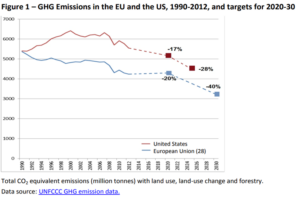This blog was written for the RSA Blog Student Summer Series that will highlight graduate student success in regional studies across the globe throughout the summer.
Various studies have acknowledged and highlighted the significant contribution of an integrated system to adopt and execute climate action plans. This article will attempt to unveil the influence of a region’s type on the successful execution of adopted climate change mechanisms. Contrary to conventional theories, this article assumes that confederal regions are more successful in implementing climate change mechanisms and objectives compared to a solitary state (federation). In comparison with the US, the EU’s experience in sharing technologies at an intra-state level when respecting instruments such as Article 12, 17, 4 and 6 of the Kyoto Protocol.

Defining Terms and Articles of the Kyoto Protocol Articles
A federation is identified as a set of states, countries or provinces which function independently and possess internal affairs of their own but are governed by a central government. Federations are often considered to differ in their “legislative and fiscal decentralization” compared to other systems. A confederation is a “union of states bound together by a permanent treaty which while not creating a new state, nonetheless, involved in the exercise of fundamental powers”.
Thus, the similarity between these two systems is that of separation between a centralized vs. national government. However, what is worth highlighting is that states under a federation are often not considered subjects under international law. Thus, not considered as counterparts of other countries.
Next, let’s look more closely at the Kyoto Protocol. Article 12 of the Kyoto Protocol concerns development of a Clean Mechanism whereby States included in Annex II could develop sustainable mechanisms to fulfil the purposes of Kyoto Convention by the help of an Annex I country. Article 17 of the Kyoto protocol establishes the right for having an Emission Trading System (ETS). Article 6 of the Kyoto Protocol refers to joint implementation between an Annex I country and Annex II. Article 4 of the Kyoto protocol allows for a distribution of reduction targets based on Parties’ own criteria.
Differences in approach from the US and EU
It is important to acknowledge that for the past 10 years, the US legislation has not dedicated any new laws at a federal level to tackle the climate change. In relation to emission reduction, US lacks cooperation abilities which in turn is a necessity for purposes of emission trading. Emission trading seems to be unsuccessful within the US’ states. An explanatory factor for this trend of inefficiency can be the US’ interpretation of trading system. It seems that the US has perceived “trading” to be an action that can take place within separate countries and not within its states.
On the other hand, it is observed that the US is active in emission trading of SO2 and NOX This illustrates a more diverse approach towards emission reduction. This means that the aim for the US is not limited to CO2 reduction but rather a diverse set of greenhouse gas emissions. However, according to the United States Environmental Protection Agency, the main emission trading program adopted by the US was NOX Budget Trading Program from 2003-2008.
Moreover, despite initiatives such as Climate Action Plan in 2013, reducing the Greenhouse gas emission to 17% below 2005 levels by 2020 – this goal seem to not have been met.
The EU Emission Trading Scheme is the most well-known instrument or mechanism in the discourse of trading emissions. This is done through installations that “surrender a number of allowances equivalent to their verified CO2 emissions” in one year. In the European Union, the target for reducing greenhouse gas emission was below 20% of 1990 levels in the year 2020. For this purpose, climate legislation of the EU encompasses “ecodesign and energy labelling, the Renewable Energy Directive, the Energy Efficiency Directive, CO2 limits for cars and vans, and legislation on fluorinated gases”. Although the latter depends on each individual EU member states, the emission trading system requires an effort from all member states at a confederation level.
Applying these terms and articles in practice
When comparing the efforts to reduce GHG emissions, the below graph illustrates a more successful trend for the EU compared to the US.

Despite the prospect of entering into trade within the US, it interpreted the terms of trading mechanism as entering into trade with oversea countries. Since according to Article 12 of the Kyoto Protocol and its Annexes, the listed states are independent countries, it is important to note that the US’ interpretation could not be blamed.
The lack of cooperation among US states has limited its option to enter into efficient mechanisms such as trading or complying with Articles 12, 6 and 4 of the Kyoto Protocol with international counterparts. Thus, it has limited its cooperation with developing countries such as India, Brazil, China and Indonesia.
Moreover, the level of commitment (whether ratified climate change conventions and bound by such instruments) affects the region’s efficiency in responding to climate change.
Another factor is the type of government ruling the country. The centralized government in the federal system of the US is expected to harmonize any mechanisms directed to reduce the effects of climate change much more successfully compared to that of a confederation. Whereas at the EU level, passing laws and mechanisms to tackle climate change relies on the initiative of the Commission and the effort of the Parliament, in US, climate policies have to pass through congress, the president and the supreme Court makes it hard for any climate change action to be effective in the US.
Moreover, since implementation by a group of countries is permitted under Article 4 of the Kyoto Protocol, countries that are already in a region have a better prospect to cooperate with one another compared to countries that need to look for partners for this purpose.

Lily Zanjani is an Advanced LL.M. student of Public International Law at Leiden University. She holds and LL.M from Tilburg University and is currently interning at the International Criminal Court and International Centre for Counterterrorism. The views expressed in this article are the author’s alone.
Are you currently involved with regional research, policy, and development? The Regional Studies Association is accepting articles for their online blog. For more information, contact the Blog Editor at rsablog@regionalstudies.org.